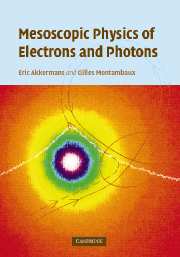Book contents
- Frontmatter
- Contents
- Preface
- How to use this book
- 1 Introduction: mesoscopic physics
- 2 Wave equations in random media
- 3 Perturbation theory
- 4 Probability of quantum diffusion
- 5 Properties of the diffusion equation
- 6 Dephasing
- 7 Electronic transport
- 8 Coherent backscattering of light
- 9 Diffusing wave spectroscopy
- 10 Spectral properties of disordered metals
- 11 Universal conductance fluctuations
- 12 Correlations of speckle patterns
- 13 Interactions and diffusion
- 14 Orbital magnetism and persistent currents
- 15 Formulary
- References
- Index
4 - Probability of quantum diffusion
Published online by Cambridge University Press: 06 January 2010
- Frontmatter
- Contents
- Preface
- How to use this book
- 1 Introduction: mesoscopic physics
- 2 Wave equations in random media
- 3 Perturbation theory
- 4 Probability of quantum diffusion
- 5 Properties of the diffusion equation
- 6 Dephasing
- 7 Electronic transport
- 8 Coherent backscattering of light
- 9 Diffusing wave spectroscopy
- 10 Spectral properties of disordered metals
- 11 Universal conductance fluctuations
- 12 Correlations of speckle patterns
- 13 Interactions and diffusion
- 14 Orbital magnetism and persistent currents
- 15 Formulary
- References
- Index
Summary
This chapter contains a description of essential concepts and tools which will be used throughout the book. We take ħ = 1.
The average Green function describes the evolution of a plane wave in a disordered medium, but it does not contain information about the evolution of a wave packet. For optically thick media, or for metals, most physical properties are determined not by the average Green function, but rather by the probability P(r, r′, t) that a particle will move from some initial point r to a point r′, or possibly return to its initial point.
In this chapter, starting from the Schrödinger equation (or the Helmholtz equation), we establish a general expression describing the quantum probability for the propagation of a particle, i.e., a wave packet, from one point to another. When this probability is averaged over a random potential we can identify, in the weak disorder limit kle ≫ 1, three principal contributions:
the probability of going from one point to another without any collision;
the probability of going from one point to another by a classical process of multiple scattering;
the probability of going from one point to another by a coherent process of multiple scattering.
We will show that the last two processes, called respectively Diffuson and Cooperon, satisfy a diffusion equation in certain limits.
Definition
Starting from the Schrödinger equation, we want to determine the probability of finding a particle of energy ∈0 at point r2 at time t, if it was initially at r1 at t = 0.
- Type
- Chapter
- Information
- Mesoscopic Physics of Electrons and Photons , pp. 92 - 147Publisher: Cambridge University PressPrint publication year: 2007

